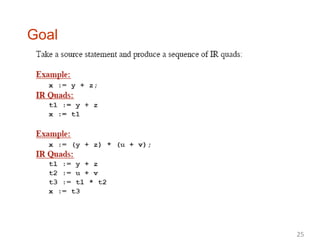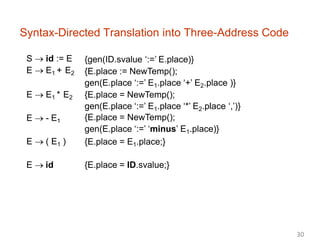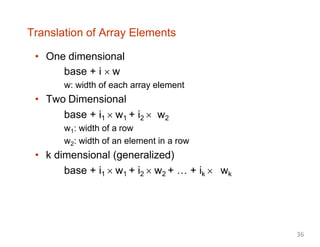Lecture 12 intermediate code generation
- 2. Compiler Architecture Parser Static Checker Intermediate Code generator Code Generator Intermediate Code Target language Front End Back End • m n compliers can be built by writing m front ends and n back ends – save considerable amount of effort • We assume parsing, static checking and IC generation is done sequentially – These can be combined and done during parsing • Static checking – Operator operand compatibility – Proper placement of break/continue keywords etc. 2
- 3. Intermediate Code (IC) • The given program in a source language is converted to an equivalent program in an intermediate language by the IC generator. • Ties the front and back ends together • Language and Machine neutral • Many forms • Level depends on how being processed • More than one intermediate language may be used by a compiler 3
- 4. • Intermediate language can be many different languages, and the designer of the compiler decides this intermediate language. – syntax trees can be used as an intermediate language. – postfix notation can be used as an intermediate language. – three-address code (Quadraples) can be used as an intermediate language • we will use quadraples to discuss intermediate code generation • quadraples are close to machine instructions, but they are not actual machine instructions. – some programming languages have well defined intermediate languages. • java – java virtual machine • prolog – warren abstract machine • In fact, there are byte-code emulators to execute instructions in these intermediate languages. Intermediate Code (IC) 4
- 6. Intermediate Languages Types • Graphical IRs: – Abstract Syntax trees – Directed Acyclic Graphs (DAGs) – Control Flow Graphs • Linear IRs: – Stack based (postfix) – Three address code (quadruples) 6
- 7. Graphical IRs • Abstract Syntax Trees (AST) – retain essential structure of the parse tree, eliminating unneeded nodes. • Directed Acyclic Graphs (DAG) – compacted AST to avoid duplication – smaller footprint as well • Control flow graphs (CFG) – explicitly model control flow 7
- 8. ASTs and DAGs: := a + ** b - (uni) c := a + b - (uni) b * - (uni) c c a := b *-c + b*-c AST DAG 8
- 9. Implementation of DAG/AST: Value Number Method 9
- 10. Three-Address Code • A three-address code is: x := y op z where x, y and z are names, constants or compiler- generated temporaries; op is any operator. • But we may also the following notation for three-address code (it looks like a machine code instruction) op y,z,x apply operator op to y and z, and store the result in x. • We use the term “three-address code” because each statement usually contains three addresses (two for operands, one for the result). 10
- 11. Linearized Representation of DAG/AST • Source Code – a = b * -c + b * -c • Three address code • Tree Representation 11
- 12. Three-Address Statements Binary Operator: op y,z,result or result := y op z where op is a binary arithmetic or logical operator. This binary operator is applied to y and z, and the result of the operation is stored in result. Ex: add a,b,c gt a,b,c addr a,b,c addi a,b,c Unary Operator: op y,,result or result := op y where op is a unary arithmetic or logical operator. This unary operator is applied to y, and the result of the operation is stored in result. Ex: uminus a,,c 12
- 13. Three-Address Code • Two concepts – Address – Instruction • Address – Name: source-program names to appear as addresses – Constant: Different types of constants – Compiler Generated temporary: 13
- 14. Three-Address Instruction Assignment Type 1: x := y op z op is a binary arithmetic or logical operation x, y and z are addresses Assignment Type 2: x := op z op is a unary arithmetic or logical operation x and z are addresses Copy Instruction:x := y x and z are addresses and x is assigned the value of y 14
- 15. Three-Address Instructions Unconditional Jump: goto L We will jump to the three-address code with the label L, and the execution continues from that statement. Ex: goto L1 jmp 7 Conditional Jump 1: if // jump to L1 // jump to the statement 7 x goto L and if False x goto L We will jump to the three-address code with the label L if x is TRUE and FALSE, respectively. Otherwise, the following three-address instruction in sequence is executed next. Conditional Jump 2: if x relop y goto L We will jump to the three-address code with the label L if the result of y relop z is true, and the execution continues from that statement. If the result is false, the execution continues from the statement following this conditional jump statement. 15
- 16. Three-Address Statements (cont.) Procedure Parameters: param x Procedure Calls: call p,n where x is an actual parameter, we invoke the procedure p with n parameters. 16
- 17. Three-Address Statements (cont.) Indexed Assignments: x := y[i] sets x to the value in location i memory units beyond location y y[i] := x sets contents of the location i memory units beyond location y to the value of x Address and Pointer Assignments: x := &y sets the r-value of x to l-value of y x := *y where y is a pointer whose r-value is a location sets the r-value of x equal to the contents of that location *x := y sets the r-value of the object pointed by x to the r-value of y 17
- 18. Three address code example do i=i+1; while (a[i] < v) L: t1=i+1 100: t1 = i +1 i=t1 101: i = t1 t2=i*8 102: t2=i*8 t3=a[t2] 103: t3=a[t2] if t3 < v goto L 104: if t3 < v goto 100 (A) Symbolic Labels (B) Position Numbers 18
- 19. Representing 3-Address Statements op, arg1, arg2, result • x = minus y – Does not use arg2 • x = y – Op is = • param a1 – Uses neither arg2 nor result • Conditional/Unconditional jumps – Put the target label in result 19
- 20. Quadruples • a = b * -c + b * -c
- 21. Quadruples • Store each fields directly 21
- 22. Triples op arg1 arg2 [ ]= x i := 0 y 0 1 22
- 25. Goal 25
- 26. Synthesized Code and Place Attributes 26
- 27. Evaluating the attributes for code generation 27
- 28. Three-address code for expression 28
- 29. Incremental Translation • ‘code’ attribute can be long string • Instead of building up ‘E.code’ – We arrange to generate new three-address instructions – ‘code’ attribute is not used – ‘gen’ method is used instead of ‘IR’ • ‘gen’ constructs a three address instruction and appends it to the sequence of instructions generated so far 29
- 30. Syntax-Directed Translation into Three-Address Code S id := E E E1 + E2 E E1 * E2 E - E1 E ( E1 ) {gen(ID.svalue ‘:=’ E.place)} {E.place := NewTemp(); gen(E.place ‘:=’ E1.place ‘+’ E2.place )} {E.place = NewTemp(); gen(E.place ‘:=’ E1.place ‘*’ E2.place ‘,’)} {E.place = NewTemp(); gen(E.place ‘:=’ ‘minus’ E1.place)} {E.place = E1.place;} E id {E.place = ID.svalue;} 30
- 31. Addressing Array Elements • Elements of arrays can be accessed quickly if the elements are stored in a block of consecutive locations. A one-dimensional array A: baseA low i width baseA is the address of the first location of the array A, width is the width of each array element. low is the index of the first array element … … 31
- 32. Addressing Array Elements (cont.) baseA+(i-low)*width can be re-written as i*width + (baseA-low*width) should be computed at run-time can be computed at compile-time • So, the location of A[i] can be computed at the run-time by evaluating the formula i*width+c where c is (baseA- low*width) which is evaluated at compile-time. • Intermediate code generator should produce the code to evaluate this formula i*width+c (one multiplication and one addition operation). 32
- 33. Two-Dimensional Arrays • A two-dimensional array can be stored in – either row-major (row-by-row) or – column-major (column-by-column). • Most of the programming languages use row-major method. • Row-major representation of a two-dimensional array: row1 row2 rown 33
- 34. Two-Dimensional Arrays (cont.) • The location of A[i1,i2] is baseA+ ((i1-low1)*n2+i2-low2)*width baseA is the location of the array A. low1 low2 is the index of the first row is the index of the first column n2 is the number of elements in each row width is the width of each array element • Again, this formula can be re-written as ((i1*n2)+i2)*width + (baseA-((low1*n1)+low2)*width) should be computed at run-time can be computed at compile-time 34
- 35. Multi-Dimensional Arrays • In general, the location of A[i1,i2,...,ik] is (( ... ((i1*n2)+i2) ...)*nk+ik)*width + (baseA- ((...((low1*n1)+low2)...)*nk+lowk)*width) • So, the intermediate code generator should produce the codes to evaluate the following formula (to find the location of A[i1,i2,...,ik]) : (( ... ((i1*n2)+i2) ...)*nk+ik)*width + c • To evaluate the (( ... ((i1*n2)+i2) ...)*nk+ik portion of this formula, we can use the recurrence equation: e1 = i1 em = em-1 * nm + im 35
- 36. Translation of Array Elements • One dimensional base + i w w: width of each array element • Two Dimensional base + i1 w1 + i2 w2 w1: width of a row w2: width of an element in a row • k dimensional (generalized) base + i1 w1 + i2 w2 + … + ik wk 36
- 37. Translation of Array References • Need to relate the address calculation formulas to a grammar for array references • Consider the non-terminal L to generate an array L € L [E] | id [E] • Nonterminal L has three synthesized attributes – L.addr denotes a temporary used to compute the offset for array reference ij x wj – L.array is a pointer to the symbol-table entry • L.array.base is used to determine the actual l-value of it – L.type is the type of sub-array generated by L • L.type.width gives the width of the type 37
- 38. Syntax-Directed Translation into Three-Address Code S id := E; | L := E; {gen(ID.svalue ‘:=’ E.place)} {gen(L.array.base ‘[’ L.addr ‘]’ ‘:=’ E.place)} E E1 + E2 | id | L {E.place := NewTemp(); gen(E.place ‘:=’ E1.place ‘+’ E2.place )} {E.place = ID.svalue;} {E.place = NewTemp(); gen(E.place ‘:=’ L.array.base ‘[’ L.addr ‘]’);} L id [E] | L1 [E] {L.array = ID.svalue; L.type = L.array.type.elem; L.addr = NewTemp(); gen(L.addr ‘:=’ E.place ‘*’ L.type.width)} {L.array = L1.array; L.type = L1.type.elem; t = NewTemp(); L.addr = NewTemp(); gen(t ‘:=’ E.place ‘*’ L.type.width); gen(L.addr ‘:=’ L1.addr ‘+’ t)} 38
- 39. Thank You 39

















![Three-Address Statements (cont.)
Indexed Assignments:
x := y[i]
sets x to the value in location i memory units beyond location y
y[i] := x
sets contents of the location i memory units beyond location y to
the value of x
Address and Pointer Assignments:
x := &y
sets the r-value of x to l-value of y
x := *y where y is a pointer whose r-value is a location
sets the r-value of x equal to the contents of that location
*x := y
sets the r-value of the object pointed by x to the r-value of y
17](https://image.slidesharecdn.com/lecture12intermediatecodegeneration-151115034147-lva1-app6892/85/Lecture-12-intermediate-code-generation-17-320.jpg)
![Three address code example
do i=i+1; while (a[i] < v)
L: t1=i+1 100: t1 = i +1
i=t1 101: i = t1
t2=i*8 102: t2=i*8
t3=a[t2] 103: t3=a[t2]
if t3 < v goto L 104: if t3 < v goto 100
(A) Symbolic Labels (B) Position Numbers
18](https://image.slidesharecdn.com/lecture12intermediatecodegeneration-151115034147-lva1-app6892/85/Lecture-12-intermediate-code-generation-18-320.jpg)



![Triples
op arg1 arg2
[ ]= x i
:= 0 y
0
1
22](https://image.slidesharecdn.com/lecture12intermediatecodegeneration-151115034147-lva1-app6892/85/Lecture-12-intermediate-code-generation-22-320.jpg)









![Addressing Array Elements (cont.)
baseA+(i-low)*width
can be re-written as i*width + (baseA-low*width)
should be computed
at run-time
can be computed
at compile-time
• So, the location of A[i] can be computed at the run-time by
evaluating the formula i*width+c where c is (baseA-
low*width) which is evaluated at compile-time.
• Intermediate code generator should produce the code to
evaluate this formula i*width+c (one multiplication and
one addition operation).
32](https://image.slidesharecdn.com/lecture12intermediatecodegeneration-151115034147-lva1-app6892/85/Lecture-12-intermediate-code-generation-32-320.jpg)

![Two-Dimensional Arrays (cont.)
• The location of A[i1,i2] is
baseA+ ((i1-low1)*n2+i2-low2)*width
baseA is the location of the array A.
low1
low2
is the index of the first row
is the index of the first column
n2 is the number of elements in each row
width is the width of each array element
• Again, this formula can be re-written as
((i1*n2)+i2)*width + (baseA-((low1*n1)+low2)*width)
should be computed
at run-time
can be computed
at compile-time
34](https://image.slidesharecdn.com/lecture12intermediatecodegeneration-151115034147-lva1-app6892/85/Lecture-12-intermediate-code-generation-34-320.jpg)
![Multi-Dimensional Arrays
• In general, the location of A[i1,i2,...,ik] is
(( ... ((i1*n2)+i2) ...)*nk+ik)*width + (baseA-
((...((low1*n1)+low2)...)*nk+lowk)*width)
• So, the intermediate code generator should produce the codes
to evaluate the following formula (to find the location of
A[i1,i2,...,ik]) :
(( ... ((i1*n2)+i2) ...)*nk+ik)*width + c
• To evaluate the (( ... ((i1*n2)+i2) ...)*nk+ik portion of this formula,
we can use the recurrence equation:
e1 = i1
em = em-1 * nm + im
35](https://image.slidesharecdn.com/lecture12intermediatecodegeneration-151115034147-lva1-app6892/85/Lecture-12-intermediate-code-generation-35-320.jpg)

![Translation of Array References
• Need to relate the address calculation formulas to a
grammar for array references
• Consider the non-terminal L to generate an array
L € L [E] | id [E]
• Nonterminal L has three synthesized attributes
– L.addr denotes a temporary used to compute the offset
for array reference ij x wj
– L.array is a pointer to the symbol-table entry
• L.array.base is used to determine the actual l-value of it
– L.type is the type of sub-array generated by L
• L.type.width gives the width of the type
37](https://image.slidesharecdn.com/lecture12intermediatecodegeneration-151115034147-lva1-app6892/85/Lecture-12-intermediate-code-generation-37-320.jpg)
![Syntax-Directed Translation into Three-Address Code
S id := E;
| L := E;
{gen(ID.svalue ‘:=’ E.place)}
{gen(L.array.base ‘[’ L.addr ‘]’ ‘:=’ E.place)}
E E1 + E2
| id
| L
{E.place := NewTemp();
gen(E.place ‘:=’ E1.place ‘+’ E2.place )}
{E.place = ID.svalue;}
{E.place = NewTemp();
gen(E.place ‘:=’ L.array.base ‘[’ L.addr ‘]’);}
L id [E]
| L1 [E]
{L.array = ID.svalue;
L.type = L.array.type.elem;
L.addr = NewTemp();
gen(L.addr ‘:=’ E.place ‘*’ L.type.width)}
{L.array = L1.array;
L.type = L1.type.elem;
t = NewTemp();
L.addr = NewTemp();
gen(t ‘:=’ E.place ‘*’ L.type.width);
gen(L.addr ‘:=’ L1.addr ‘+’ t)}
38](https://image.slidesharecdn.com/lecture12intermediatecodegeneration-151115034147-lva1-app6892/85/Lecture-12-intermediate-code-generation-38-320.jpg)
